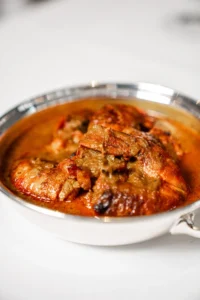Authentic Hyderabadi Biryani: The Art of Preparation
Authentic Hyderabadi Biryani stands out in Indian cuisine, offering a rich blend of flavours, fragrant spices, and tender meat. Many people consider it a culinary masterpiece. This article explores its history, ingredients, preparation, and cultural significance. Additionally, it highlights why mastering this dish can be a rewarding challenge.
The History of Hyderabadi Biryani
Origins
Biryani traces its roots back to Persian cuisine. The Mughal emperors introduced this dish to India, particularly during the 16th century. Over time, it evolved into various regional styles. Hyderabad, in particular, became famous for its unique version of biryani.
Mughal Influence
The Mughals combined rice and meat dishes with fragrant spices to create delicious meals. They brought saffron, cardamom, and other spices from Persia, which contributed to the flavour profile we recognise today. As a result, Hyderabadi Biryani reflects this rich cultural heritage. It showcases the art of cooking that has lasted for centuries.
Evolution Over Time
As trade routes opened and cultures blended, simultaneously Hyderabadi Biryani continued to evolve. Moreover, local chefs adapted the dish, incorporating local spices and cooking techniques. As a result, these adaptations led to variations in flavour, aroma, and texture, allowing the dish to become a staple in many Indian households. Today, it is synonymous with celebrations and gatherings across India.
Essential Ingredients for Hyderabadi Biryani
Meat Selection
Traditionally, Hyderabadi Biryani uses goat or chicken. The meat chosen significantly impacts the dish’s overall flavour. Chefs marinate the meat in a blend of spices to enhance its taste. This marination process ensures that the meat becomes tender and absorbs all the flavours. You can also find vegetarian versions using paneer or mixed vegetables, making it accessible for everyone.
Rice
Basmati rice is crucial for this dish. Its long grains provide the perfect texture for biryani. Chefs typically use aged basmati rice for better flavour and aroma. The quality of the rice can make a significant difference in the final outcome of the dish.
Spices
A variety of spices make the biryani unique. Common spices include:
- Cumin: Adds warmth and earthiness to the dish.
- Cardamom: Offers a sweet and floral note that balances the spices.
- Cloves: Provide a strong, aromatic flavour that enhances the overall taste.
- Saffron: Enhances colour and imparts a subtle richness. It is often steeped in warm milk or water before adding it to the rice.
Fresh Ingredients
Using fresh ingredients is essential for making an authentic biryani. Onions, tomatoes, mint, and coriander leaves elevate the dish. Fresh herbs add brightness and balance the spices, creating a harmonious flavour profile. The freshness of these ingredients directly affects the dish’s taste and aroma.
The Preparation Method
Marinating the Meat
Marinating the meat is a crucial step in preparing Hyderabadi Biryani. Ideally, it is best to marinate the meat for several hours, preferably overnight, to allow the flavours to penetrate deeply. Additionally, use a mixture of yoghurt, ginger-garlic paste, and a blend of spices for marination. Consequently, this process tenderises the meat and infuses it with rich flavour. Ultimately, proper marination sets the foundation for a delicious biryani.
Cooking the Rice
- Rinse the Rice: Rinse basmati rice in cold water until it runs clear. This step removes excess starch and prevents stickiness in the final dish. It is essential for achieving fluffy rice.
- Soak the Rice: Soak the rice in water for at least 30 minutes. This process helps the grains absorb water before cooking, resulting in perfectly cooked rice.
Layering the Biryani
- Cook the Meat: In a heavy-bottomed pot, heat oil and sauté sliced onions until golden brown. This step adds sweetness and depth of flavour to the dish.
- Add Marinated Meat: Once the onions are browned, add the marinated meat to the pot and cook until it is browned on all sides. This step seals in the juices and flavours.
- Incorporate Tomatoes and Herbs: Stir in chopped tomatoes and fresh herbs, such as mint and coriander. Cook until the tomatoes soften and meld with the meat. The combination of meat and tomatoes adds another layer of flavour.
- Layer the Rice: Once the meat is cooked, layer the soaked rice over it. Spread the rice evenly across the meat for proper cooking and absorption of flavours.
- Dum Cooking: Seal the pot with dough or a tight lid to trap the steam. Cook on low heat for 30 to 40 minutes. This method allows the flavours to meld perfectly, resulting in a fragrant and delicious biryani.
The Dum Technique
Sealing the Pot
Sealing the pot is crucial for proper cooking. This technique traps steam and retains moisture, ensuring the rice cooks evenly. It allows the rice to absorb the meat’s flavours while remaining fluffy. Achieving the right seal is essential to ensure that no steam escapes during the cooking process.
Cooking on Low Heat
Cooking on low heat ensures that the rice and meat cook evenly without burning. This method allows the flavours to blend harmoniously. The dum technique requires patience, but the result is worth the wait. The slow cooking process transforms the ingredients into a cohesive dish.
Cultural Significance of Hyderabadi Biryani
A Dish for Celebrations
Hyderabadi Biryani holds a special place in Indian culture. It often appears during festivals, weddings, and family gatherings. Its presence brings people together, celebrating the joy of sharing food. Each bite is a testament to the effort and care put into preparing this dish.
Symbol of Hospitality
Serving biryani to guests demonstrates warmth and hospitality. It showcases the host’s effort in preparing a special meal. In Hyderabad, biryani often signifies a grand feast. This tradition reinforces the cultural importance of sharing food with loved ones.
Regional Variations
Various regions in India have developed their own styles of biryani. For instance, Kolkata Biryani features boiled eggs and potatoes, while Lucknowi Biryani is known for its fragrant rice and tender meat. These regional variations reflect the diversity of Indian cuisine and its ability to adapt to local ingredients and tastes. Each style tells a unique story, contributing to the rich tapestry of Indian culinary traditions.
Authentic Hyderabadi Biryani: Variations
Kacchi Biryani
Kacchi Biryani uses raw marinated meat, which cooks along with the rice. This method ensures maximum flavour infusion. Kacchi Biryani requires careful marination and cooking to achieve perfection. The meat absorbs the spices and flavours from the rice during the cooking process, resulting in a richly flavoured dish.
Pakki Biryani
Pakki Biryani involves cooking the meat separately before layering it with rice. This method allows for more control over cooking times. It results in tender meat and fluffy rice, making it a popular choice for home cooks. The individual components are cooked to perfection before being combined, ensuring a delightful eating experience.
Vegetarian Biryani
Vegetarian versions offer a delicious alternative for those who prefer plant-based meals. Chefs use mixed vegetables, paneer, or mushrooms as the main ingredients. They follow the same preparation method, ensuring a rich flavour profile. Vegetarian biryani is equally aromatic and satisfying, providing a hearty meal for everyone.
Layered Biryani
Another variation is layered biryani, where each component is cooked separately. The rice, meat, and vegetables are cooked independently and then layered together. This technique allows for precise control over the texture and flavour of each element. It is often garnished with fried onions, raisins, and nuts for added richness.
Tips for Mastering Hyderabadi Biryani
Use Quality Ingredients
To achieve the best results, always choose fresh, high-quality ingredients. In particular, fresh herbs and spices make a significant difference in taste and aroma. Moreover, invest in good-quality basmati rice, and don’t compromise on the quality of meat or vegetables.
Practice Patience
Patience is key when cooking biryani. Allow the meat to marinate properly and let the rice cook slowly. This patience pays off with rich flavours that develop over time. Rushing through the process can lead to less-than-ideal results, so take your time.
Experiment with Spices
Feel free to adjust spice levels to suit your taste; additionally, you can increase or decrease spices based on your preference. Furthermore, experimenting with different spice blends can lead to exciting variations and personalisation of the dish.
Get the Technique Right
Master the dum cooking technique for the best results. Practice sealing the pot correctly and maintaining low heat throughout the cooking process. With time, you will perfect this essential skill. Consistency is key to achieving the perfect biryani every time.
Serve with Accompaniments
Biryani is often served with raita, a yogurt-based side dish. Raita helps balance the spices and adds a cooling element to the meal. You can also serve it with salad or pickles for extra flavour. These accompaniments enhance the overall dining experience, making it more enjoyable.
Authentic Hyderabadi Biryani: Conclusion
In conclusion, Hyderabadi Biryani represents a culinary journey through history and culture. Its complex flavours and rich preparation make it a unique dish. Mastering this dish not only provides a delicious meal but also connects you to the rich heritage of Indian cuisine. By following the techniques and tips outlined in this article, you can embark on your journey to create an authentic Hyderabadi Biryani. Enjoy the process, savour the incredible flavours of this remarkable dish, and share it with your loved ones.
As you dive into the world of Hyderabadi Biryani, remember that every preparation tells a story. Each spice and ingredient reflects the history and culture of India. So, gather your ingredients, embrace the art of cooking, and enjoy the delightful experience of creating this iconic dish in your kitchen.

